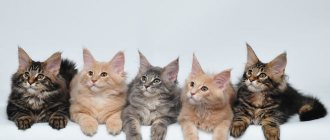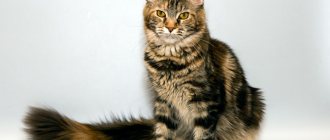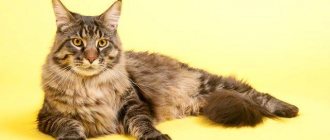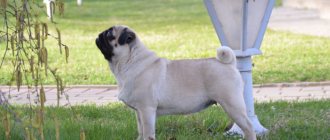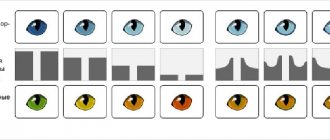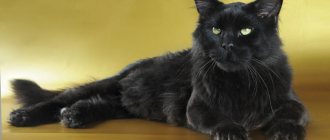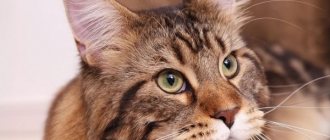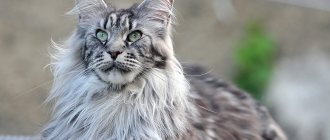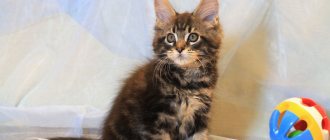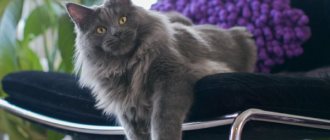From a genetic point of view, Maine Coons have two main coat colors – red and black. All other shades are different variations of the basic ones. All the variety of colors and patterns appears due to the special distribution of hair pigment, which determines the color of the animal.
Determining the hereditary color allows you to find out which cat's offspring will appear. Maine Coons are no exception here. To do this, breeders use special tables with formulas that will tell the color of future kittens. Based on them, you can decide how to cross the adults to get the desired result.
Maine Coons of different shades.
Traditional Maine Coon colors: photos and descriptions
There are several types of coat patterns called tabby.
They all have their own patterns. Tabby was inherited from the wild ancestors of modern domestic Maine Coons. Their distinctive feature is the letter “M”, which is visible in the area of the cat’s forehead and eyes with light or dark lines. There are three types of tabby:
- Tigers. The stripes on the body are parallel to each other.
- Spotted. There are spots of dark and light shades on the sides.
- Classic. Similar to the pattern of marble.
There is also a fourth type - ticked, but it is not typical for this breed. It is usually found in the Abyssinian breed and other oriental cats. It may appear in isolated coon individuals.
Often there are uniform colors in the same range; they are called solid or in the English version - solid (uniform). In this case, the tabby can be almost invisible. Often found in cats that are black in color. The darker the cat, the weaker the pattern of its coat appears. Tabby is especially pronounced in cats with fur of red (red) shades. Solids can be in the following palette:
- black;
- cream;
- red;
- smoky;
- blue.
Smoky gray and blue are of particular interest to Maine Coon breeders, as they are very rare for representatives of this breed. The gallery below shows photos of popular colors.
Maine Coon color calculator
To understand what color will result from crossing animals, breeders use a calculator table. With its help, you can predict with a very high probability what color the offspring of a thoroughbred couple will inherit.
How the coat colors of Maine Coon offspring interbreed.
This is, of course, not a guaranteed result, as it is impossible to calculate the exact genetic combination a kitten will inherit. From time to time, extremely interesting representatives of coons are born, having, for example, tortoiseshell tones, which is very rare for this breed. It has been noticed that most of these individuals are female.
Gray Maine Coon
Gray or blue colors are considered rare for this breed.
An even color of blue shades is a rare occurrence. A smoky shade is usually found. These cats look special; their color gives them their aristocratic charm. If a cat is exactly like this, it means that the gene responsible for the presence of a pattern on the body has been completely suppressed.
Blue tones are specially developed through selective breeding. This takes a lot of time and effort from breeders. The letter “A” is placed in the passport of such a kuna. If the cat has two-color fur, the code “03” is added to the letter designation.
Origin story
Maine Coons boast a rich 150-year history. Much is known about the development and formation of the breed, but the appearance of such large cats in the north of America is shrouded in secrets and legends. One of them says that cats are the fruit of love between a cat and a raccoon. From the latter they inherited their large size and striped tail. According to another legend, Maine Coons have the blood of North American lynxes. As proof of this version, many cite the well-known tassels on the ears. However, the truth is that they are the result of selection; 100 years ago many representatives of the breed did not have these tassels, and even today not everyone has them. Realistic felinologists believe that, first of all, this is a population of domestic cats that formed naturally. Over the decades, these cats have been honed by nature itself, which has made them physically hardy and large animals, perfectly adapted to harsh winter conditions and hunting.
Since ancient times, “raccoon” cats lived on Maine farms and fought with numerous rodents, protecting grain supplies. But only the hardiest and largest individuals with well-developed muscles and gorgeous appearance took part in further targeted selection under human guidance. Maine Coons are rightfully considered the national pride of America. Since the mid-19th century they have already begun to be talked about as a separate breed. At one of the fairs, farmers even organized an exhibition where Men's raccoon cats competed for the title of Meime State Champion coon cat. Undoubtedly, this speaks of their high popularity and love of the local population. Further, large cities also became interested in cats from Mena. They began to appear at exhibitions in Boston and New York, where they competed with another popular breed at that time - the Angora cat.
In 1895, at the Madison Square Garden New York cat show, the beautiful Maine Coon Kuzi became a star and received the title Best of Show. It was a brown tabby cat (initially only those could belong to the breed, but later the palette expanded significantly). In 1908, at an exhibition organized by the CFA in Boston, the fifth Maine Coon was registered, his name was Molly Bond. Over the next 10 years, the popularity of the breed grew exponentially, they began to be exported to other countries and actively improved their external characteristics. However, since 1911 there has been a lull. For 40 years, Maine Coons have not appeared at any specialized exhibition. Apparently, this was due to the emergence of other, more interesting breeds.
Thanks to the enthusiasm of raccoon cat lovers from 1966 to 1968, a breakthrough was made and the champion title was returned to the giant. In 1968 there were six, which is still in operation today. In 1976, the Maine Coon breed was officially recognized, and by 1980 about 200 nurseries and thousands of fanciers were registered. There were certain standards and Maine Coons began their triumphal march around the world, winning the hearts of millions with their incredible appearance and peaceful nature.
Video review about Maine Coon cats:
The rarest and most expensive Maine Coon colors
Each breed has rare colors that are not often seen. Maine Coons are no exception. This breed has its own rare shades:
- Brown with spots. These kittens have a color similar to autumn foliage.
- Creamy blue. Looks like tortoiseshell with rare pastel shades.
- Chintz. This is a unique coloring for coons. The base is red, diluted with black tones with white splashes.
- Watered down chintz. There are cream-colored spots on a white background, and blue colors have a solid coloring.
- Spotted with white spots.
Such colors are not typical for coons and are rare.
Smoky
Such cats can be black or blue. The intensity of the haze determines the subspecies:
| Name | Description |
| Chinchilla | Only the tip of the hair is pigmented |
| Shaded | color has a quarter of the hair |
| Smoke | Only the root of the hair is colored white, the main part has black or blue pigments |
| True smoke | Half of the hair has pigmentation |
| Silver | the hair is white at the root, the rest is light silver |
| Cream | at birth, the coat is uniform in color, but gradually becomes unevenly pigmented |
| Classic wild | brindle, marbled black, spotted |
Smoky cats are characterized by white roots. Gray is usually found in monochromatic animals.
Chocolate
The wool is colored brown, warm, rich. The presence of inclusions of other shades or patterns is not allowed. The hairs have an even distribution of pigment. Unlike red tones, it is darker and deeper. Quite rare in breeding. The paw pads and nose also have brown tones.
Classic wild
This color suggests the presence of a pattern on the animal's fur. They can be of different types:
- brindle;
- marble black;
- spotted.
These are the main colors of coons that were common among their wild ancestors.
Peach
These cats have similar features to their cream counterparts. These can be yellow, orange shades characteristic of tabby coons.
Black
Black monochromatic coloring is extremely rare for this breed.
Each black coon has a different color depth and saturation, so it is impossible to find two identical black cats. Usually, this color hides the pattern on the coat. In small kittens it can be difficult to see, but as they grow older it is completely hidden. The cat becomes completely monochrome. An animal with black fur looks regal, luxurious, reminiscent of a majestic panther in appearance.
Black and white
Cats with this coloration have different proportions of these colors:
- Black with white spots. There are several small spots of white on the fur.
- White medallion. A white spot is located on the chest of the animal, reminiscent of decoration.
- White gloves. The cat has black and only white paws of the animal.
- White tuxedo. There is a white shirtfront on the neck, and the paws are also white.
- Bicolor. Black and white in a 1/1 ratio.
- Harlequin. The color is predominantly white with a few black spots.
- Wang. The head and tail are painted black. The rest of the body is white.
What is the danger of white color
White Coons have a predisposition to complete deafness.
It is found in this color much more often than in animals with a different shade of fur. However, there is no need to be upset by this fact. Deaf individuals feel great.
They live well in the house, and are oriented to the area no worse than healthy ones. Their hearing loss is compensated by vision and a keen sense of smell. People who do not know about cat deafness will not guess about it.
Cream
This shade is obtained by lightening the red. The animals are colored in shades similar to raw ginger. When crossing, individuals with genetically weakly expressed pigment in the pedigree are preferred. However, theoretically, even Black Solid Maine Coons can produce cream-colored offspring.
Features of the character and care of animals
Maine Coons are very observant animals, as scientists have proven, they can do conscious actions. Not many felines can raise their offspring together, but a cat and a Maine Coon cat do it together. These cats have an excellent memory, which allows them to remember several commands from their owner.
Cats will get along well with other animals and children, as they love to be held. It takes time for a pet to get used to a new person, so cats treat guests with caution. Maine Coons are very loyal animals, this devotion is comparable to that of a dog, and they are also easy to train. These are very energetic pets, they need to move a lot, there must be enough space for this.
Since Maine Coons have very long and thick fur, it requires careful and constant care. To prevent the fur from getting tangled, it should be combed; for this, special combs with rounded teeth are used, this is necessary so as not to injure the delicate skin of the animal. Cats love to wash themselves and are neutral to water, so they can be washed easily
The ears of these animals are a weak point, they should be given special attention, they need to be cleaned with a soft cloth, the inner surface of the shells should have a pink tint
Maine Coons love high places, so their personal space should be high. Owners who live on the upper floors should be careful about open windows in the rooms. Since Maine Coons are large, they cannot group themselves correctly when falling, which is why accidents happen to animals.
Animals love meat, so they must have it in their diet, but you shouldn’t chop it finely; chewing food will strengthen the cats’ jaws. The diet should not contain fish, milk, and cats should not be given pork or lamb. Kittens of this breed are born quite large in size, they are very playful and active, they are almost always busy, and when they find themselves in an unfamiliar place, they will completely explore the room. You can buy Maine Coon kittens at the age of 12 weeks and above.
You can buy kittens in a specialized nursery, the price for them is not small. Here everything will depend on the color, gender and age of the animal, and it is also worth considering why the pet will be acquired. If the animal will not be shown at exhibitions, and there are slight deviations from certain standards, then their price starts from 20,000 rubles. Of course, on the Internet there are a lot of advertisements for the sale of these kittens at a lower price, but they are usually not purebred. And it is worth remembering that the natural colors of Maine Coons will always cost much more.
You will learn more about marbled Maine Coons in the following video.
Tortoiseshell
The tortoiseshell Maine Coon comes in two types – torby and torty.
The first type is a combination of red and black shades of wool, expressed in a dark brown color. The torti has a greater addition of red with dark cream. Of particular interest is the fact that tortoiseshell coloring is most often found in cats.
The probability of a male being born with this coloring is approximately 1 in 1000.
On such cats, markings of different sizes and shapes are more clearly visible. Based on the severity of these spots, several colors can be distinguished:
- calico;
- flap;
- chintz.
These cats are characterized by the presence of red shades of fur. The classic color, consisting of three colors, is obtained by mixing black and red. This makes the coat more variegated. There are also several tortoiseshell shades.
Scaly tortoiseshell
Reminiscent of fish scales, the order of spots on the body is checkerboard. These spots alternate in black and red tones and are unevenly distributed. Any one of the colors may predominate.
Calico and solid tortoiseshell (patchwork)
The spots of black and red color resemble flaps. They have defined boundaries and can overlap each other. If the wool has white patches, this color is called “tortoiseshell white” or calico. Red and black spots are solid in color and clearly visible on the animal’s body.
Patterned tortoiseshell
Multi-colored spots have a pronounced pattern. These may be spots or stripes, but marbled colors are also common. There may be small white spots. In this case, it is fashionable to say that the color is spotted tabby or tabby with white spots.
Marble colors
Can be cold or warm tones. The first has more gray tones, while the warm one is dominated by brown shades. These stains sparkle in the sun in a special way, which many people like. Such stains can be drawn in different ways - stripes, spots, contours. Such spots can be well defined, then they are more reminiscent of a tortoiseshell color. Marble coloring has more diffuse, blurred borders of spots.
Tabby
This type of coloring is present in all representatives of the Maine Coon breed, but may not be expressed in a bright form. This color is a genetic predisposition. A cat's hair has its own zoning or striping. The wild ancestors were tabbies, which was inherited by modern representatives. There are various options for this design.
Classic, spotted and brindle tabby
Characterized by wide stripes of a spiral shape. They are usually located on the sides of the animal, and can resemble marble stains. Spotted tabbies have intermittent stripes or spots of color throughout the animal's body. The brindle tabby is similar to the brindle coloring - vertical stripes along the entire length of the body.
Ticked Tabby
These cats have no stripes or spots at all. The fur has a peculiar pattern on the face, paws, and chest. Ticking is the distribution of pigment along the hair. The tip has a rich shade, gradually losing brightness towards its root.
Red single color (solid)
In fact, redness implies rich terracotta or cream shades of fur without light tan marks or a smoky effect. Each hair must be completely dyed. In the place where the patterns are located on the fur, the shade is 2-3 times stronger. The coat of this color is always accompanied by a pattern, so Maines do not have uniform redness.
To read: Types and varieties of shepherd dogs
Random color combination
Sometimes there are situations when the maine has a color that does not fit any of the color types. For this purpose, its own classification was created. These colors can be called:
- Brown tabby with spots. Such an animal has spots of red and brown.
- Blue spotted tabby. The cat in this case has cream and blue stripes on its body.
- Creamy blue. The spots are scattered in a chaotic manner throughout the body. This color is sometimes called a blue turtle.
- Creamy blue, white.
- Spotted tabby with white spots. The color is similar to the previous one, but there are inclusions of white spots.
Such combinations are also rare.
Unrecognized
Chocolate, gold, and lilac colors are not allowed at specialized exhibitions. Coons with Siamese coat color are also not recognized. There are patterns that are considered unrecognized for the Coons. These can be called:
- faun;
- cinnamon;
- point;
- sorrel;
- acromelanic color.
The coat color of Maine Coons is distinguished by a huge variety of colors and their combinations. The eyes of purebred animals must match the color of their fur. They can be blue (only pure white wool), green, yellow. White individuals may have different colored eyes (blue and green).
EMS color code
The International Association of Felinologists has developed a table that includes color options recognized by professional breeders. We need such a systematic collection for the convenience of making entries in the pedigree of the animal, bringing information about the breed to a single standard.
Unified table of coat colors according to EMS coding.
Thus, all colors not included in the standard coding are considered coat color defects. Individuals with unrecognized colors are not allowed at exhibitions and are not used in breeding.
However, they are suitable for home keeping in the same way as those with coat colors included in the table. Representatives of this breed have many genetically determined color options. Each Maine Coon is beautiful in its own way, no matter what color nature gave it.
Origin story
The northwestern United States is considered the birthplace of this breed. It was there, in Maine, that these incredible creatures first saw the light of day. In confirmation of this origin, the breed even received the name Maine Coon. Despite the logic of this fact, many build their own theories about creating pets.
Some consider the unusual creatures to be a combination of the genes of cats and raccoons. This theory is supported by the Maine Coon's tail color. Others replace raccoon with lynx in this DNA cocktail. The reason for this hypothesis is the tassels on the ears of these cats.
Most experts are still inclined to believe that animals appeared as a result of evolution.
